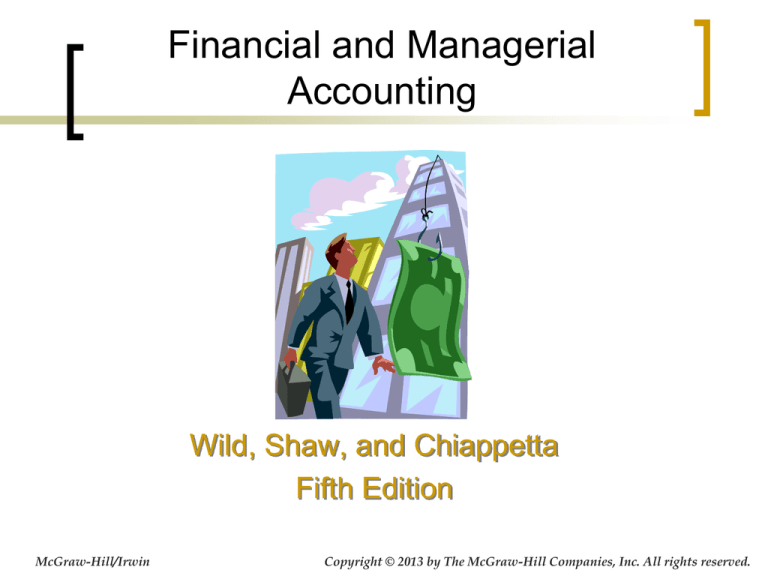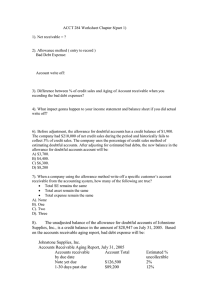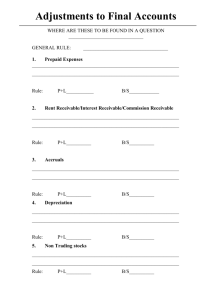
Financial and Managerial
Accounting
Wild, Shaw, and Chiappetta
Fifth Edition
McGraw-Hill/Irwin
Copyright © 2013 by The McGraw-Hill Companies, Inc. All rights reserved.
Chapter 7
Accounts and Notes Receivable
Conceptual Learning Objectives
C1: Describe accounts receivable and
how they occur and are recorded.
C2: Describe a notes receivable, the
computation of its maturity date, and
the recording of its existence.
C3: Explain how receivables can be
converted to cash before maturity.
7-3
Analytical Learning Objectives
A1: Compute accounts receivable
turnover and use it to help assess
financial condition.
7-4
Procedural Learning Objectives
P1: Apply the direct write-off method to
account for accounts receivable.
P2: Apply the allowance method and estimate
uncollectibles based on sales and accounts
receivable.
P3: Record the honoring and dishonoring of a
note and adjustments for interest.
7-5
C1
Accounts Receivable
Amounts due from
customers for credit sales.
Credit sales require:
Maintaining a separate
account receivable for
each customer.
Accounting for bad
debts that result from
credit sales.
7-6
C1
Sales on Credit
and Accounts Receivable Subsidiary Ledger
On July 16, Barton, Co. sells $950 of
merchandise on credit to Webster Co., and
$1,000 of merchandise on account to Matrix, Inc.
DR
950
Jul. 16 Accounts Receivable - Webster
Sales
CR
950
To record credit sales to Webster Co.
Accounts Receivable - Matrix
Sales
1,000
1,000
To record credit sales to M atrix, Inc.
7-7
C1
Sales on Credit
and Accounts Receivable Subsidiary Ledger
Subsidiary Ledger
Accounts Receivable Ledger
Webster Co.
Date
PR Debit Credit
Jul. 16
950
Balance
950
Matrix, Inc.
Date
PR Debit Credit
Jul. 16
1,000
Balance
1,000
Schedule of
Accounts Receivable
Webster Co.
$ 950
Matrix, Inc.
1,000
Total
$ 1,950
Control Account
General Ledger
Accounts Receivable
Date
PR Debit Credit Balance
Jul. 16
1,950
1,950
7-8
C1
Sales on Credit
and Accounts Receivable Subsidiary Ledger
On July 31, Barton, Co. collects $500 from Webster
Co., and $800 from Matrix, Inc. on account.
Jul. 31 Cash
Accounts Receivable - Webster
DR
500
CR
500
To record cash collections on account
Cash
Accounts Receivable - Matrix
800
800
To record cash collections on account
7-9
C1
Sales on Credit
and Accounts Receivable Subsidiary Ledger
Subsidiary Ledger
Accounts Receivable Ledger
Webster Co.
Date
PR Debit Credit
Jul. 16
950
Jul. 31
500
Balance
950
450
Matrix, Inc.
Date
PR Debit Credit
Jul. 16
1,000
Jul. 31
800
Balance
1,000
200
Schedule of
Accounts Receivable
Webster Co.
$ 450
Matrix, Inc.
200
Total
$ 650
Control Account
General Ledger
Accounts Receivable
Date
PR Debit Credit Balance
Jul. 16
1,950
1,950
Jul. 31
1,300
650
7-10
C1
Credit Card Sales
Advantages of allowing customers to
use credit cards:
Customers’
credit is
evaluated by
the credit
card issuer.
Sales increase by
providing payment
options to the
customer.
The risks of extending
credit are transferred to
the credit card issuer.
Cash collections
are quicker.
7-11
C1
Credit Card Sales
With some credit cards and nearly all debit
cards, the seller deposits the credit card
sales receipts in the bank just like it
deposits a customer’s check.
The bank increases the balance in the
company’s checking account.
The company usually pays a fee of 1%
to 5% of card sales, for the service.
7-12
C1
Credit Card Sales, Cash Received
Immediately on Deposit
On July 16, 2013, Barton Co. has a bank credit
card sale of $500 to a customer. The bank
charges a processing fee of 2%. The cash is
received immediately.
Jul. 16 Cash
Credit Card Expense
Sales
DR
490
10
CR
500
To record credit card sales
7-13
C1
Credit Card Sales, Cash Received
Sometime After Deposit
On July 16, 2013, Barton Co. has a credit card sale of
$500 to a customer. The credit card company charges
a processing fee of 2%. Barton remits the credit card
sale to the credit card company and waits for the
payment that is received on July 28.
Jul. 16 Accounts Receivable - Credit Card Co.
Credit Card Expense
Sales
DR
490
10
CR
500
To record credit card sales and fees.
Jul. 28 Cash
490
Accounts Receivable - Credit Card Co.
490
To record receipt of cash from credit card company
7-14
C1
Installment Accounts Receivable
Amounts owed by customers from credit sales for
which payment is required in periodic amounts over
an extended time period. The customer is usually
charged interest, which is the cost for the use of
money over time.
7-15
P1/P2
Valuing Accounts Receivable
Some customers may not pay
their account. Uncollectible
amounts are referred to as bad
debts. There are two methods
of accounting for bad debts:
Direct write-off method
Allowance method
7-16
P1
Direct Write-Off Method
On August 4, Barton determines it
cannot collect $350 from Martin, Inc.,
a credit customer.
Aug. 4
Bad Debts Expense
Accounts Receivable - Martin
DR
350
CR
350
To write off uncollectible account
7-17
P1
Direct
DirectWrite-Off
Write-Off Method
Method
On September 9, Martin decides to pay $200 of
the amount previously written off.
Sep. 9
Accounts Receivable - Martin
Bad Debts Expense
DR
200
CR
200
To reinstate account previously written off
Sep. 9
Cash
200
Accounts Receivable - Martin
200
To record payment on account
7-18
P1
Matching vs. Materiality
The matching
(expense recognition)
principle requires
expenses to be reported
in the same accounting
period as the sales they
help produce.
The materiality
constraint states
that an amount can
be ignored if its
effect on the
financial statements
is unimportant to
users’ business
decisions.
7-19
P2
Allowance Method
At the end of each period, an estimate is made of the
total bad debts expected to be realized from that
period’s sales.
There are two advantages to the allowance method:
1. It records estimated bad debts expense in the
period when the related sales are recorded.
2. It reports accounts receivable on the balance
sheet at the estimated amount of cash to be
collected.
7-20
P2
Recording Bad Debts Expense
(under the allowance method)
At the end of its first year of operations, Barton Co.
estimates that $3,000 of its accounts receivable will
prove uncollectible. The total accounts receivable
balance at December 31, 2013, is $278,000.
Dec. 31 Bad Debts Expense
Allowance for Doubtful Accounts
DR
3,000
CR
3,000
To record estimated bad debts
Contra-asset account
Bal.
Accounts Receivable
278,000
Allowance for Doubtful Accounts
Dec. 31
3,000
7-21
P2
Recording
Bad
Debts
Expense
Recording Bad Debts Expense
(under the allowance method)
At the end of its first year of operations, Barton Co. estimates that
$3,000 of its accounts receivable will prove uncollectible. The total
accounts receivable balance at December 31, 2013, is $278,000. We
report our Accounts Receivable on the balance sheet as shown
below.
BARTON, CO.
Partial Balance Sheet
December 31, 2013
Net Realizable Value
Cash
Accounts receivable
Less: Allowance for doubtful accounts
$ 278,000
3,000
$ 275,000
7-22
P2
Estimating Bad Debts Expense
Two Methods
1. Percent of Sales Method (Income
Statement Method); and
2. Accounts Receivable Methods
(Balance Sheet Methods)
Percent of Accounts
Receivable Method
Aging of Accounts
Receivable Method.
7-23
P2
Percent
SalesMethod
Method
Percent of Sales
Bad debts expense is computed as follows:
×
=
Current period credit sales
Bad debt %
Estimated bad debts expense
Barton has credit sales of $1,400,000 in 2013.
Management estimates 0.5% of credit sales will
eventually prove uncollectible.
What is estimated bad debts expense for
2013?
7-24
P2
Percent of
Percent
ofSales
SalesMethod
Method
$
×
= $
1,400,000
0.50%
7,000
Barton’s accountant
computes estimated
Bad Debts Expense of
$7,000.
Dec. 31 Bad Debts Expense
Allowance for Doubtful Accounts
DR
7,000
CR
7,000
To record estimated bad debts
7-25
Percent of Accounts Receivable
Method
P2
Compute the desired ending balance of
the allowance for doubtful accounts.
Year-end accounts receivable
-
× Bad debt %
Bad debts expense is computed as:
Estimated adj. bal. in Allowance for Doubtful Accounts
Unadj. year-end bal. in Allowance for Doubtful Accounts
= Estimated bad debts expense
7-26
P2
Percent
of
Accounts
Receivable
Percent of Accounts Receivable
Method
Barton has $100,000 in
Accounts Receivable and an
existing $900 credit balance in
Allowance for Doubtful
Accounts on December 31,
2013. (Past experience
suggests that 4% of
receivables are uncollectible.)
Well, I have to
consider the balance
in the Allowance
Account,
so…
What is Barton’s bad debts
expense for 2013?
7-27
P2
Percent of Accounts Receivable
Percent of Accounts Receivable
Method
Desired ending balance in
Allowance for Doubtful Accounts.
$ 100,000
×
4.00%
= $
4,000
Allowance for
Doubtful Accounts
900
Dec. 31 Bad Debts Expense
Allowance for Doubtful Accounts
3,100
4,000
DR
3,100
CR
3,100
To record estimated bad debts
7-28
P2
Aging of Accounts Receivable
Method
Each receivable is grouped by
how long it is past its due date.
Each age group is multiplied
by its estimated bad debts
percentage.
Estimated bad debts for each
group are totaled.
7-29
P2
Aging of Accounts Receivable
Aging of Accounts Receivable
Method
Barton Co.
Schedule of Accounts Receivable by Age
December 31, 2013
Accounts
Estimated
Receivable
Percent
Uncollectible
Days Past Due
Balance
Uncollectible
Amount
Not yet due
1 - 30 days past due
31 - 60 days past due
61 - 90 days past due
Over 90 days past due
$
64,500
18,500
10,000
3,900
3,100
$ 100,000
1% $
3%
7%
40%
60%
$
Desired Ending
645
555
700
1,560
1,860
5,320
Balance
7-30
P2
Aging
of
Accounts
Receivable
Aging of Accounts Receivable
Method
Barton’s unadjusted existing
balance in the allowance
account is $900.
Allowance for
Doubtful Accounts
900
4,420
5,320
We estimated the desired
balance to be $5,320.
Dec. 31 Bad Debts Expense
Allowance for Doubtful Accounts
DR
4,420
CR
4,420
To record estimated bad debts
7-31
P2
Writing Off a Bad Debt under the
Allowance Method
With the allowance method, when an
account is determined to be uncollectible,
the account is written off against the
Allowance for Doubtful Accounts.
On December 27, Barton determines that
Martin’s $300 account is uncollectible.
Dec. 27 Allowance for Doubtful Accounts
Accounts Receivable - Martin
DR
300
CR
300
To writeoff an uncollectible account
7-32
P2
Recovery of a Bad Debt Under the
Allowance Method
Subsequent collections of accounts written
off require that the original write-off entry be
reversed before the cash collection is
recorded.
Feb. 8
Accounts Receivable - Martin
Allowance for Doubtful Accounts
DR
300
CR
300
To reinstate account previously written off
Feb. 8
Cash
300
Accounts Receivable - Martin
300
To record full payment on account
7-33
P2
Summary of Allowance Methods:
Estimate based
on % of Sales
Emphasis on
Matching
Sales
Bad
Debts
Exp.
Income
Statement
Focus
Estimate based on
% of Receivables
Estimate based on
an Aging of
Receivables
Emphasis on
Realizable Value
Emphasis on
Realizable Value
Accts.
Rec.
Accts.
Rec.
All. for
Doubtful
Accts.
Balance
Sheet Focus
All. for
Doubtful
Accts.
Balance
Sheet Focus
7-34
C2
Notes Receivable
Date of note
$1,000.00
Term
July 10, 2013
Payee
Ninety days
Principal
after
date I promise to pay to
the order of Barton Company, Los Angeles, CA
One thousand and no/100 --------------------------------- Dollars
Payable at
First National Bank of Los Angeles, CA
Interest Rate
Value received with interest at
No.
42
12%
Due Oct. 8, 2013
per annum
Maker
Julia Browne
Due Date
7-35
C2
Principal
of the
note
Interest Computation
×
Annual
interest
rate
×
Even for
maturities less
than one year,
the rate is
annualized.
Time
expressed
in fraction
of a year
=
Interest
If the note is
expressed in
days, base a
year on 360
days.
7-36
C2
Computing Maturity Date
and Interest
On March 1, 2013,
Matrix, Inc. purchased a
copier for $12,000 from
Office Supplies, Inc.
Matrix gave Office
Supplies a 9% note due
in 90 days in payment
for the copier.
What is the maturity
date of the note?
7-37
C2
Computing Maturity Date
and Interest
Days in March
Minus the date of the note
Days remaining in March
Days in April
Days in May to maturity
Period of the note in days
31
1
30
30
30
90
The note is due and payable on May 30, 2013.
How much interest will Matrix pay to Office
Supplies, Inc. on this note?
7-38
Computing Maturity Date
and Interest
C2
Principal
of the
note
$ 12,000
×
Annual
interest
rate
×
×
9%
×
Time
expressed = Interest
in fraction
of a year
90/360
=
$
270
Total interest due
at May 30.
7-39
C2, P3
Recognizing Notes Receivable
Here are the entries for Office Supplies Inc. to
record the note from Matrix, Inc. on March 1
and the settlement on May 30, 2013.
Mar. 1
Notes Receivable
Sales
DR
12,000
CR
12,000
Sold goods in exchange for note
DR
12,270
May 30 Cash
Interest Revenue
Notes Receivable
CR
270
12,000
Col l ected note and i nterest due
7-40
P3
Recording a Dishonored Note
On May 30, 2013, Matrix informs us that they are
unable to pay the note or interest.
DR
May 30 Accounts Receivable - Matrix
CR
12,270
Interest Revenue
Notes Receivable
270
12,000
To charge accts. Rec. for dishonored note
and to record interest earned
7-41
P3
Recording End-of-Period Interest
Adjustments
On December 1, 2013, Matrix, Inc. purchased a
copier for $12,000 from Office Supplies, Inc.
Matrix issued a 9% note due in 90 days in payment
for the copier. What adjusting entry is required on
December 31, the end of the company’s accounting
period?
$12,000 × 9% × 30/360 = $90
Dec. 31 Interest Receivable
Interest Revenue
DR
90
To accrue interest on note
CR
90
7-42
P3
Recording End-of-Period Interest
Adjustments
Recording collection of note at maturity.
Days in December
Minus the date of the note
Day remaining in December
Days in January
Days in February
Days in March until maturity
Period of the note in days
Mar. 1
31
(1)
30
31
28
1
90
DR
12,270
Cash
Interest Receivable
Interest Revenue
Notes Receivable
CR
90
180
12,000
To record full payment of note
7-43
C3
Disposing of Receivables
Companies sometimes want to convert
receivables to cash before they are
due.
They can sell or factor receivables.
They may pledge receivables as
security for a loan.
7-44
A1
Accounts Receivable Turnover
This ratio provides useful information for
evaluating how efficient management has
been in granting credit to produce revenue.
Accounts
receivable
turnover =
Net sales
Average accounts receivable, net
7-45
End of Chapter 7
7-46






